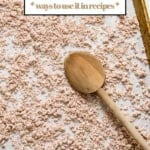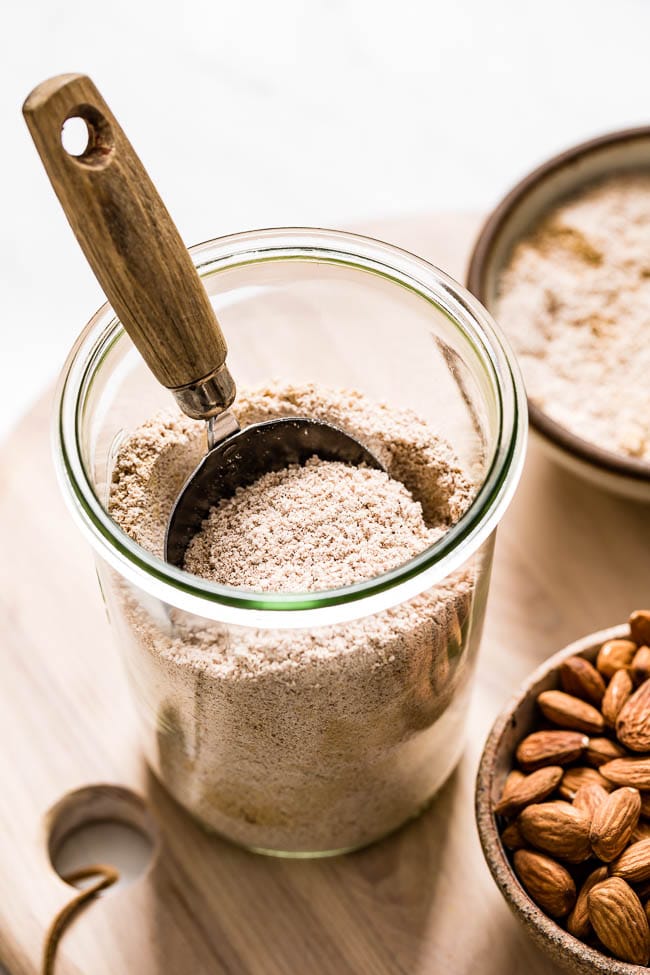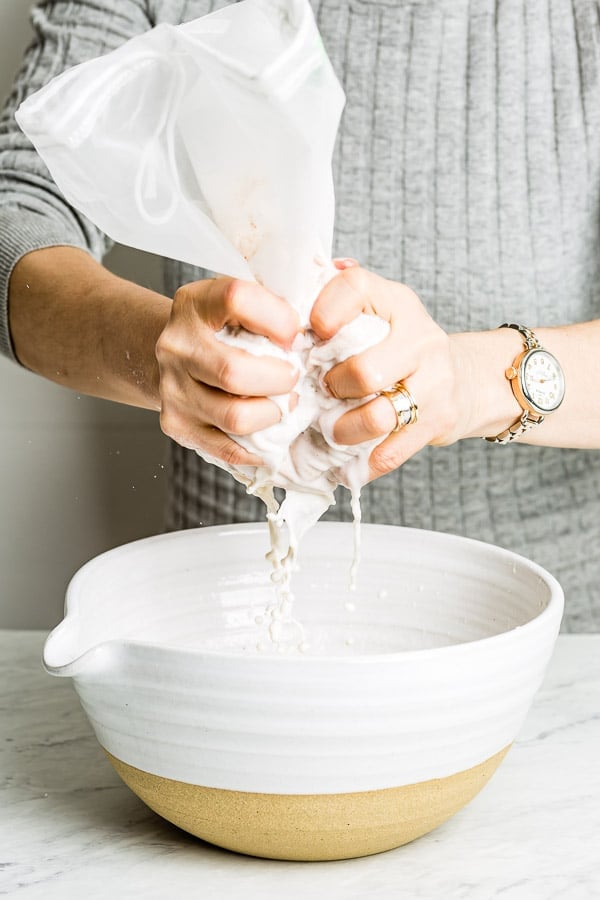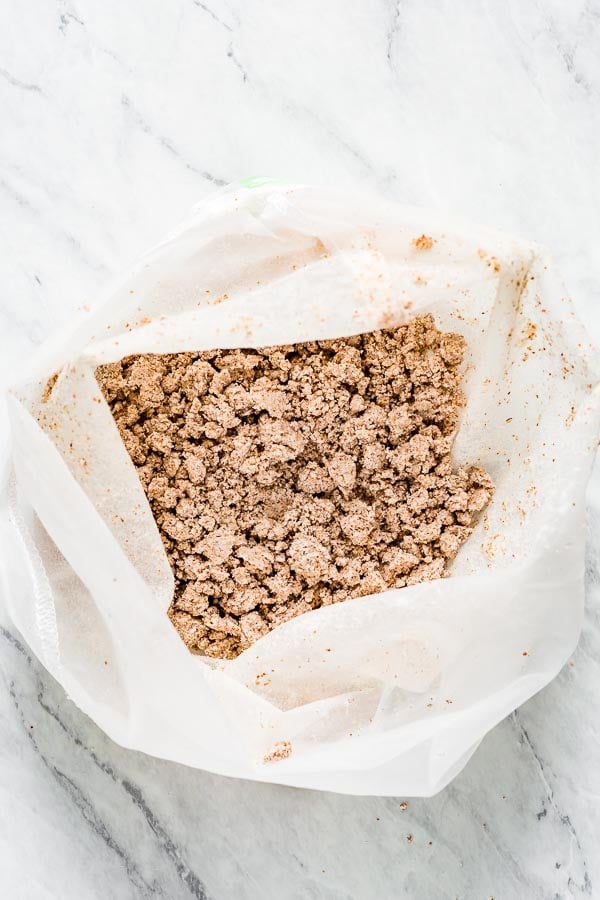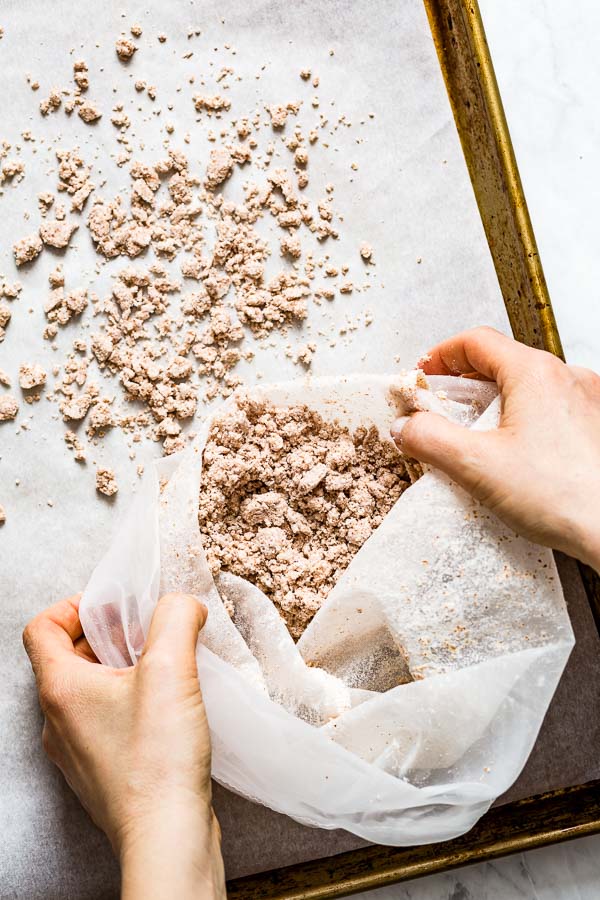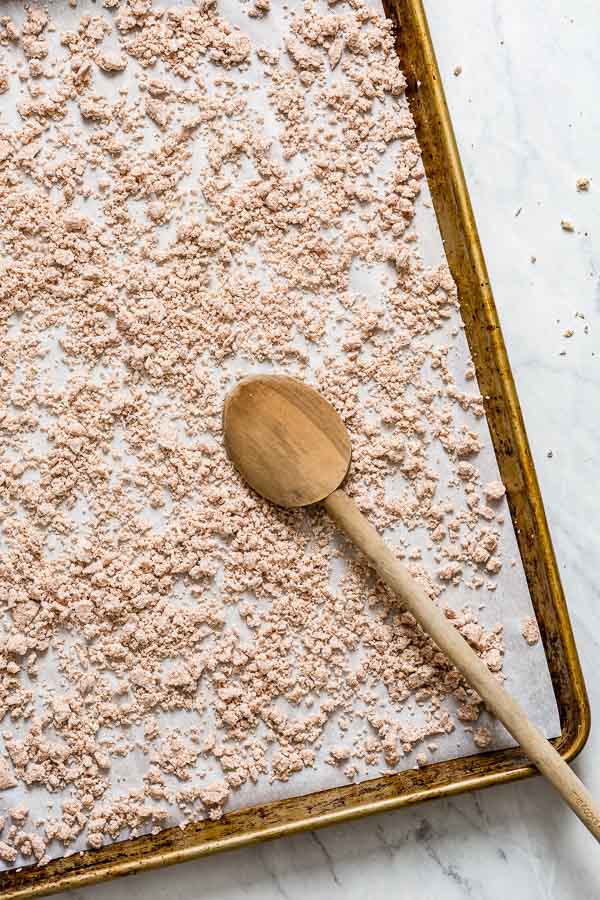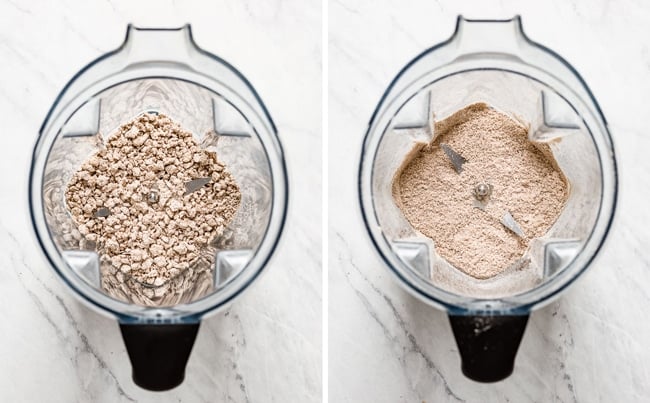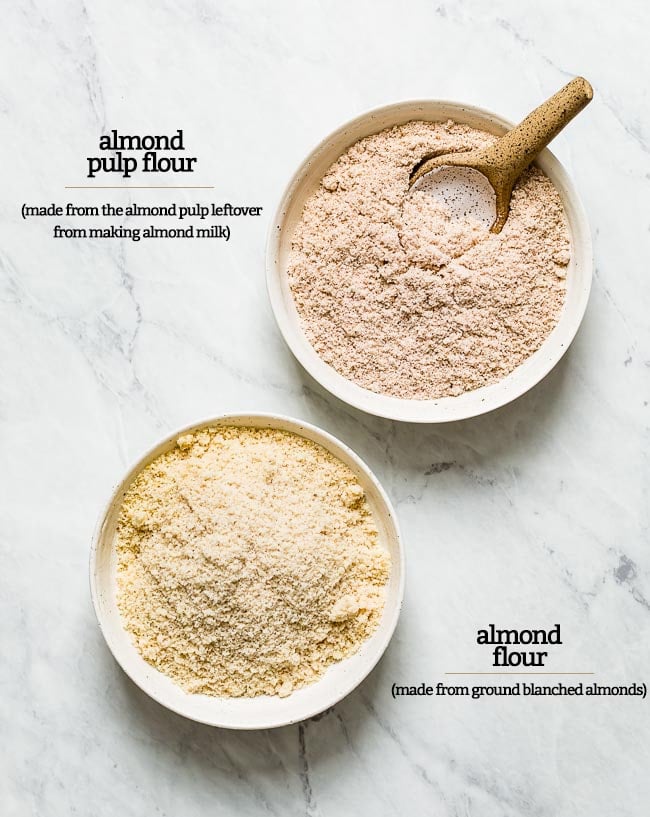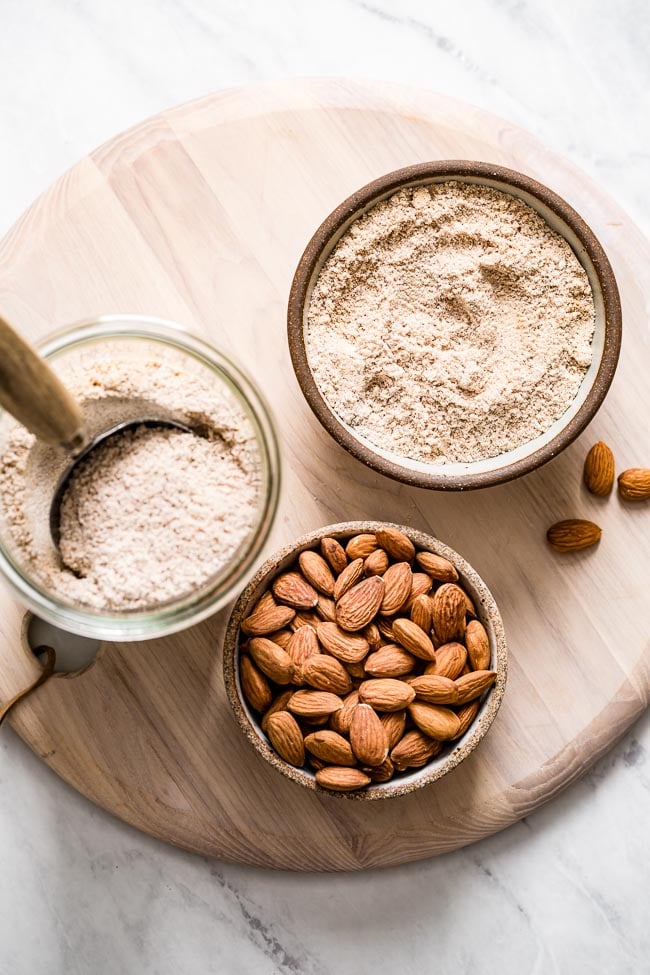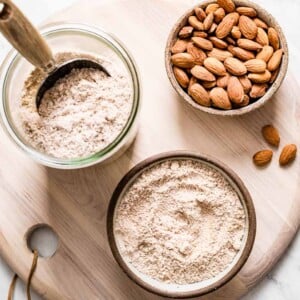I also wanted to know how would I dry, store, and use the almond pulp in my no-food-waste kitchen. If you have been there, this post is for you. Today, we are covering everything you need to know about almond pulp along with some creative ideas to put it into good use.
What Is Almond Pulp?
If you are not familiar, the process of making almond milk at home is quite simple. Soak almonds overnight, rinse and place them into the bowl of a blender on the next day. Add in water, blend, and strain. The pulp you are left with after all the liquid is extracted is what we call almond pulp. Also referred to as almond paste or almond milk paste, it is the byproduct of almond milk. After all the liquid is extracted out, at first, it looks like chunks of wet almond flour. Since it is wet, the best way to use it in recipes is to dry it out and turn it into flour using a food processor or a blender.
How To Dry Out Almond Pulp?
Before we talk about how to dry it out, I want to mention that every batch of almond pulp will differ in moisture. That is mainly because the amount of moisture depends on how much of the liquid you are able to squeeze out of the pulp. Therefore, please use the information (and the numbers) that I am sharing here with that in mind. The process of drying leftover almond pulp from making almond milk is quite simple and the steps are as follows: As I mentioned earlier, the timing depends on how much liquid you were able to squeeze out of the nut milk bag. Obviously, the more liquid you are able to extract the quicker you’ll be able to get it dried out.
Why Such A Low Heat Oven?
I’ll be honest, I am not a big fan of keeping the oven on for such a long time. While I do not like wasting food, I also don’t care about paying a very high power bill at the end of the month. So I tested this recipe in different temperature settings to see if I can save money by keeping the oven on for a shorter period of time. I tried 190 F (87 C) and 200 F (93 C) degrees. In both cases, I was able to shave off at least 45 minutes from drying time, but the high heat roasted the leftover pulp and changed its color (turned golden brown) and taste. While it did not taste bad and can definitely be an option, I found that the recipes I tried with roasted almond pulp had more of that “roasted” taste compared to one that was baked low and slow.
Can I Freeze It?
If you are conscious of your power bill like I am, one solution is to collect the pulp from every batch of almond milk you make in an airtight container and freeze it to dry the out later in bigger batches. This way you can justify the cost. I find that three batches are ideal for a large baking sheet. Another option is to invest in a dehydrator, which is supposedly the most efficient and environmentally friendly way to dry it out. However, since I do not own one and have no experience with using it I will leave it at that.
How Long Will It Be Fresh In The Fridge?
If you don’t want to freeze almond pulp, you can store it in an airtight container in the fridge for up to 3 days.
How To Make Almond Flour From Almond Pulp (Dried):
Once the pulp is dried, place it in a high powered blender (such as Vitamix). Blend until it turns into flour. In my Vitamix, this took about 10 seconds. If you do not have a blender, you can also use a food processor. It might take a little longer to pulverize it but it would still work.
How Much Almond Flour Do I Get From Using the Leftover Almond Pulp:
Let’s talk numbers. What is sold as almond flour in the market today is made from blanched almonds (aka raw almonds without the skin on), whereas almond meal is made from raw almonds with the skin on. I usually make my almond milk using raw almonds with the skin on. However, you can also make it using blanched almonds as well. My go-to homemade almond milk ratio is 1 cup raw unsalted almonds soaked in water for 8 hours and then blended with 4 cups of water. For the sake of this recipe, I am not using any sweeteners (maple syrup, dates, or honey) or any other additives (vanilla or almond extract) to flavor it.
1 cup of raw almonds weighs ~ 5.2 ounce1 cup of raw almonds soaked in water for 8 hours weighs ~ 6.8 ounceThe leftover pulp dried out in a low-heat (180 F degree oven) for 2 ½ hours and pulverized in a blender yields a little over half a cup of almond pulp flour that is ~ 1 ounce.
How Is Almond Meal Made From Almond Pulp Different That Actual Almond Flour?
Before I provide you with almond pulp recipes and other uses of it, let’s talk about the difference between almond pulp flour and almond flour/meal (made from ground almonds):
Can I Use It In Recipes That Call Almond Meal or Almond Flour?
The answer is that it depends on the recipe. As I was preparing for this post, I tested two of my most popular almond flour recipes; Almond Flour Chocolate Cake and Almond Flour Cookies. The difference was considerably different in that the version made with almond pulp flour ended up drier and denser than the version made with almond flour. This is not to say that it was bad, but it ended up being a different kind of chocolate cake and cookie. I’d say denser and less moist. In their cookbook, Sweet Laurel: Recipes For Whole Food, Grain-Free Desserts (affiliate link), Laurel Gallucho & Claire Thomas, shares the following. If you are not familiar, this cookbook is all about baked goods made (mostly) with almond flour and almond meal. In conclusion, in order to make it work, you would have to adjust the amount of liquid and fat used in the recipe to compensate for the lack of body (weight) and fat (texture) content. And perhaps, follow in the footsteps of Laurel and Claire, and use 50% nut milk pulp and 50% almond flour. Luckily, we came up with a sustainable solution. We bought the almond meal leftover from milk production and dehydrated it to make our own flour. The residual meal is quite dry, as the fat has been stripped from the almonds, so in our recipes, we like to use 50/50 mix of homemade and store-bought almond flour.
Using Raw Almond Pulp in Recipes:
The good thing is that you can use the undried raw almond pulp in so many recipes. Here are a few ideas:
Add a few tablespoons in your breakfast smoothies: This is a really good way of adding extra fiber into your diet.Use it in breakfast bowls: Add in a few tablespoons of almond pul into your overnight steel-cut oatmeal or almond milk oatmeal to give them a subtle almond flavor and boost your daily fiber intake.Incorporate it into your energy bar recipes: Add a few tablespoons of almond pulp when you make your own kind bars or cocoa truffles for extra body and fiber.As Gluten-Free Alternative to Bread Crumbs: Since almonds are naturally gluten-free, its pulverized dry version makes a great substitute for gluten-free bread crumbs.
